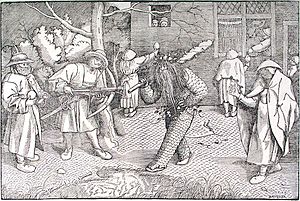Coronation of Edward VI facts for kids
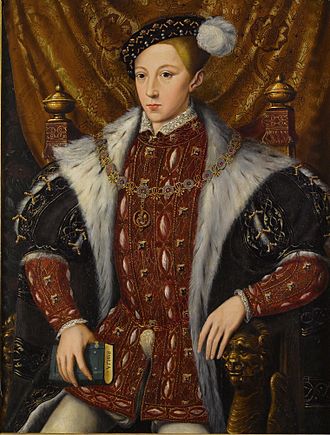
Portrait of Edward VI
|
|
| Date | 20 February 1547 |
|---|---|
| Location | Westminster Abbey, London, England |
| Participants |
|

The coronation of Edward VI as King of England and Ireland happened at Westminster Abbey in London on February 20, 1547. Edward became king after his father, King Henry VIII, passed away.
Contents
Becoming King
Henry VIII died on January 28, 1547. Edward was only nine years old at the time. He traveled from Hertford Castle to Enfield, where he met his older half-sister Elizabeth. He was officially announced as king on January 30. Edward later wrote that his father died from a sickness. Henry VIII was buried at Windsor next to Jane Seymour, Edward's mother, on February 16.
Important advisors, called the Privy Council, discussed Henry VIII's will to decide who would rule next. Edward's uncle, Edward Seymour, 1st Duke of Somerset, became the Lord Protector. This meant he was like a temporary ruler who helped Edward.
The coronation was planned for Shrove Sunday. Edward's older half-sisters, Mary and Elizabeth, were not at the coronation. This might have been because of their rank or the cost.
A New Crown for the King
Three different crowns were used for the coronation. One was a brand new "imperial" crown. It was made by a goldsmith named Everard Everdyes. This crown was crafted from gold, precious stones, and pearls. The word "imperial" means it had raised arches, like a dome.
Everdyes used old gold from the royal jewel collection. He also used pearls from Henry VIII's hats and necklaces. The new crown might have even included the famous large red gem called the Black Prince's Ruby. This special stone came from Myanmar.
Everdyes also made a smaller crown for the Duke of Somerset, Edward's uncle. It was decorated with diamonds that belonged to Henry VIII.
The Royal Procession
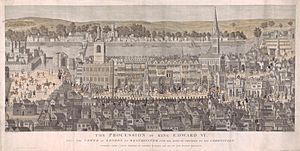
On February 19, the day before the coronation, Edward and his group traveled in a grand parade. They went from the Tower of London through the city of London to Westminster. Edward wore a very fancy silver gown embroidered with gold. Sometimes, he walked a little ahead of the special canopy held over him. This was so "the people might better see his grace."
The people of London paid taxes to help fund the shows and performances along the parade route. At Cheapside, Edward was greeted by actors playing Valentine and Orson. These were twin brothers from old stories. One was raised by a bear and became a "wild man." The other was raised as a courtier. In the pageant, they promised to protect King Edward.
The shows at Cheapside were based on a performance from 1432. That show was for Henry VI of England when he returned from France.
At Fleet Street, an actress playing "Ancient Truth" spoke to Edward. She said Henry VIII had brought her back and hoped Edward would be like a "young King Solomon" (a wise king from the Bible).
At St Paul's, a performer from Aragon in Spain did amazing tricks. He slid down a cable or tightrope from the church steeple. He went "so swiftly as he had been a bird." Edward watched him do more tricks and "laughed right hartely" (laughed very heartily). This was the only place where the parade stopped for a long time. Sometimes, the king even passed by shows and ignored speeches.
The Coronation Ceremony
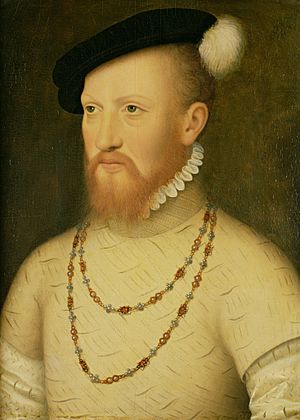
The ceremony took place in Westminster Abbey. The famous Coronation Chair was used. This chair, described as the "great white chair," was covered with rich white fabrics. It had carved lions and a fleur-de-lis (a symbol like a lily) on it. The chair was placed on a raised stage.
Edward showed himself to the crowd at different parts of the stage. Thomas Cranmer, the Archbishop of Canterbury, asked the people to agree to the coronation. He invited them to show their loyalty. As Edward needed to move around the Abbey, ushers carried him in a special portable chair.
The Coronation Oath (the promises the king makes) was changed for Edward. This was because of the Reformation, a time of big changes in the church. The new oath mentioned that laws would be made "by the consent of your people." This was a hint at the role of Parliament of England.
In his sermon, Archbishop Cranmer said Edward would be like the Biblical King Josiah. Josiah destroyed pagan idols. Cranmer said Edward would make sure "the tyranny of the Bishops of Rome" (meaning the Pope) was removed. He also said "images removed" (meaning religious statues and pictures).
The Archbishop of Canterbury crowned Edward. Edward's uncle, the Duke of Somerset, helped with the crowning. They brought three crowns to the altar: the new crown, the Imperial State Crown, and St Edward's Crown. They placed them "one after another on his head."
The Coronation Feast
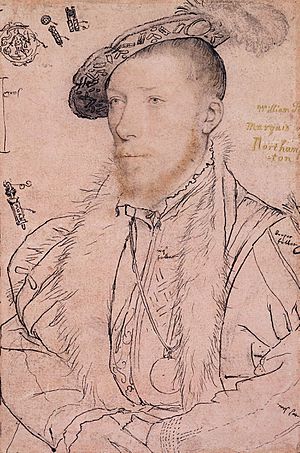
After the ceremony, Edward went to Westminster Hall for a grand feast. He wore the new crown made by Everard Everdyes. Important nobles like the Marquess of Dorset and the Earl of Arundel rode into the hall.
The Marquess of Northampton was the carver. He also "assayed" or tested the food to make sure it was safe.
At the end of the main meal, the King's Champion, a knight named Dymoke from Scrivelsby, rode into the hall wearing armor. He threw down his gauntlet (a glove) as a challenge. This was a way to ask if anyone questioned the king's right to rule. Edward gave him his gold cup as a reward. After the meal, sweet spiced wine called hippocras was served, along with sweets and sugar candies.
Tournaments and Shows
On the days after the coronation, there were exciting events. On February 21, there was jousting. On February 22, a tournament took place. Knights like Thomas Seymour and Peter Carew competed.
After the tournament, or the next evening, there was a play or "farce." It included a show about Orpheus (a musician from Greek myths). There was also a masque with actors dressed as friars and cardinals. Edward might have even performed in this show in costume!
English soldiers in Boulogne (a town in France) also held a tournament to celebrate. Instead of jousting, they had "running at the ring." One team of six soldiers dressed "like Turks." People were very impressed by a soldier named Henry Dudley.
Edward VI in Stories
The coronation of Edward VI is an important part of Mark Twain's famous 1881 novel, The Prince and the Pauper. In the story, Edward gets lost and is helped by a man named Miles Hendon. He tries to reach the Abbey before a boy who looks just like him, Tom Canty, is crowned king instead. The novel has been made into plays and movies many times.
Mark Twain might have read about the Valentine and Orson pageant when he was researching his book. There were also stories of a boy named William Featherstone who claimed to be Edward VI in 1555. He was shown to the people in Westminster Hall and later punished.
See also
- Cultural depictions of Edward VI


